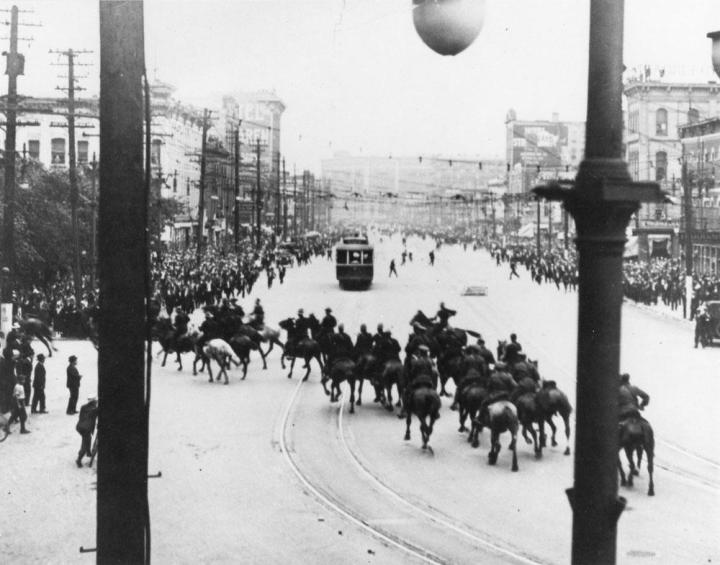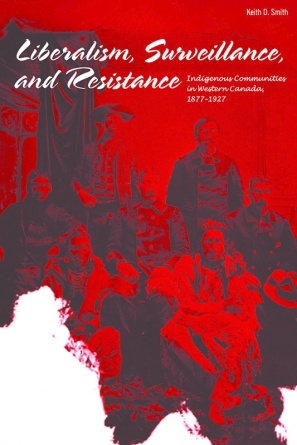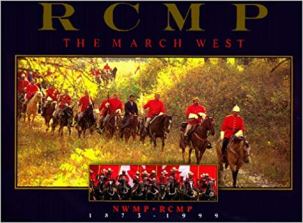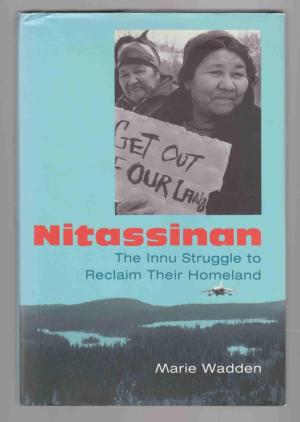By M. Gouldhawke (Métis & Cree)
Updated: March 5, 2020
(Originally published December 21, 2019)
(A condensed and edited version of this article can now be found at The New Inquiry)

“The myth of the RCMP is that they came to protect us from the whisky traders and bad guys. They came to protect the conqueror’s property and they still protect the conqueror’s property.”
– Maria Campbell, Toronto Star, 1989
The armed invasion and arrests in Wet’suwet’en territory carried out by the Royal Canadian Mounted Police (RCMP) this February that have sparked cross-country Indigenous resistance have been about more than just the enforcement of a court injunction on behalf of a natural gas pipeline company.
The RCMP may serve as Canada’s federal police force, but in relation to Indigenous peoples it is not so much a domestic policing agency as an occupying foreign army.
In the context of a previous police raid of Wet’suwet’en territory a year ago, the RCMP installed a special remote detachment along the forest-service road that leads to the decade-long-running Unist’ot’en camp and healing centre. The police force has continuously set up arbitrary exclusion zones in the area, stopping and arresting Indigenous people and their supporters without cause, as it facilitates the work of the Coastal GasLink pipeline company that is destroying the territory of Wet’suwet’en clans.
Canada was only six years old as a nation-state when it established the North-West Mounted Police (NWMP) in 1873. This original name for the RCMP outlined a colonial purpose, as the Northwest was not yet fully part of Canada at this time. The territory had been fraudulently purchased from the Hudson’s Bay Company (HBC) three years earlier and remained largely under the effective control of Indigenous nations such as the Métis, Cree, Anishinaabe, Dene and Nakota.
Indigenous effective control ran contrary to all fraudulent claims to the territory by Canada, since the HBC had never purchased the land from Indigenous peoples in the first place in order to sell it to anyone, and the Canadian military had to be sent to Red River (Winnipeg) in 1870 to remove the Métis-led Provisional Government that had been established there the year before.
Conventional Canadian mythology maintains that the RCMP were created to protect Indigenous people from marauding Americans at Cypress Hills. But even this white-washed story underlines the force’s role in expanding and maintaining the borders of Canada, while facilitating the development of infrastructure such as the Canadian Pacific Railway across Indigenous lands by whatever means necessary, from breaking workers’ strikes to forcibly relocating Indigenous people.
In reality, Canada did not seek to protect Indigenous people but to protect itself and settler corporate interests from further Indigenous resistance that would occur if settlers were allowed to run amok and Indigenous peoples decided to ally themselves with anyone other than Canada. Such resistance had already taken place at Red River and would soon raise its head again in the Northwest Resistance of 1885 in what is now called Saskatchewan.
Canada also desperately needed a paramilitary police organization to enforce its new oppressive laws, the Dominion Lands Act of 1872 and the Gradual Enfranchisement Act of 1869 (updated as the Indian Act in 1876), which were designed to control Indigenous peoples and redistribute their lands to settlers, in violation of the Numbered Treaties.
In 1874, Canadian Justice Minister A.A. Dorion admitted that the RCMP’s mission was in part to “give confidence to peaceable Indians and intending settlers.”
The Prime Minister of Canada himself, John A. Macdonald, confirmed in 1884 that “the business of the Mounted Police is principally to keep peace between white-men and Indians.”
The RCMP even reprinted a Prince Albert Daily Herald article in their own RCMP Quarterly magazine in 1961 that claimed Métis leader Louis Riel was “mainly responsible for the unsettled conditions which led to the founding of the Force.”

The RCMP’s first full-scale operation was launched in 1885 against the Métis and Cree resistance in what is now Saskatchewan. But this military engagement resulted in several resounding defeats and forced retreats for the RCMP at the hands of Indigenous warriors at the Battles of Duck Lake, Fort Pitt, Fish Creek, Cut Knife and Frenchman’s Butte, as well as an incident at Battleford where the RCMP simply hid inside their fort as Cree warriors briefly re-occupied the town.
The RCMP were so ineffective that they needed to be saved by the Canadian army (with additional British support and leadership), who eventually were able to defeat the Indigenous resistance, leading to the judicial hangings of Louis Riel and eight Cree and Nakota/Assiniboine men. The site where Riel was hanged is still today the RCMP training academy.
The RCMP then began to enforce an illegal pass system on the Prairies that restricted the movements of Indigenous people on and off reserves, to suppress Native cultural traditions such as the Sun Dance, and to apprehend Indigenous children to be forced into residential schools as part of Canada’s (ongoing) assimilation policy.
RCMP commander Sam Steele, a veteran fighter against the Métis and Cree, in 1891 wrote a letter to the police force’s commissioner recommending that Blackfoot bands be barred from participating in the Sun Dance, calling it a “relic of barbarism that should be stamped out,” also claiming that it supposedly incited males to cattle killing and horse stealing.

On the Prairies and also in Inuit territory in the north, the RCMP were more than just a police force but also occupied many other repressive functions usually thought of today as belonging to other branches of government. In some cases, the RCMP were judge, jury and executioner.
In Inuit territory, the RCMP killed thousands of sled dogs, a crucial spiritual and practical relation of the Inuit people. Similar to the purposeful wiping-out of the buffalo on the Prairies, Canada meant to deprive the Inuit of their means of subsistence and spiritual/cultural life.
In 1919, during the Winnipeg General Strike, the RCMP opened fire on a crowd of workers, killing two and injuring dozens, helping to crush the strike and win greater significance for the force in the eyes of the capitalist ruling class. In 1931, the RCMP attacked a demonstration of striking coal miners in Estevan, Saskatchewan, killing three of them. The On To Ottawa Trek of 1935, launched by relief camp workers in Vancouver, was attacked by the RCMP in Regina, Saskatchewan, resulting in a riot, two deaths and dozens of injuries on both sides, and more than 100 arrests.

The RCMP in 1923 stationed a detachment on the Six Nations of the Grand River reserve in Ontario. In response, Chief Deskaheh wrote a letter to the Prime Minister in opposition to what he called the Indian Department’s desire to place and house “Mounted Police with horses upon Indian lands without a colour of justice, right, or cause.”
The following year, Colonel C.E. Morgan, a former colonial administrator in South Africa now stationed on the reserve, along with some 20 RCMP officers raided the council house at Six Nations to remove the traditional confederacy chiefs and replace them with the Indian Act band council system. In 1959, the RCMP raided and made arrests again when traditionalists re-occupied the council house.
During World War II, in March of 1941, the RCMP began forcing all males of Japanese ancestry above the age of 16 to register with them, several months before the attack on Pearl Harbor. Later, the RCMP would engage in intimidation tactics and the removal of families of Japanese ancestry (mostly Canadian citizens) to internment camps, as well as the deportation of families to Japan.
In 1968, RCMP officers arrested dozens of Mohawks at Akwesasne who were blocking the International Bridge and border crossing which divides their reserve and wider territory between Canada and the United States, restricting their movements on their own land.

In the wake of the Quebec separatist and workers’ movements of the 1960s and ’70s, the RCMP was revealed to have engaged in a vast array of criminal activities itself, including office break-ins and even a bombing which caused RCMP Security Service Corporal Robert Samson to lose fingers and hearing. 17 RCMP officers were charged with dozens of criminal offences following a Quebec inquiry.
In 1974, the RCMP clashed with participants of the Native Peoples Caravan in front of the parliament buildings in Ottawa. The caravan had started in Vancouver and picked up participants along the way to Ottawa in an attempt to further the Indigenous resistance movement and bring grievances directly to the federal government after armed re-occupations of Cache Creek and Anicinabe Park earlier that same year.
Throughout the 1980s, there was an escalation of RCMP repression of Indigenous resistance across Canada, as for example when dozens were arrested at a blockade by members of the Blood Tribe (of the Blackfoot Confederacy) over a reserve land dispute at Cardston, Alberta in 1980; when 72 people were arrested at Haida Gwaii during logging blockades in 1985; when 27 Lubicon Cree were arrested at roadblocks against oil development in 1988; and through the latter half of the decade when some 250 arrests were made of Innu people who repeatedly re-occupied and shut down the imperialist NATO air base in Labrador, whose test flights were disrupting hunting and the Innu way of life.

While Indigenous people were being particularly over-policed at this time, they were also being under-served. The RCMP’s willful negligence in protecting Indigenous people from violent settler attacks was highlighted in this period by two particularly brutal incidents that led to significant court cases and inquiries.
One of these incidents was the failure of the RCMP to properly investigate the murder of a Cree woman, Helen Betty Osborne, by four men, only one of whom was convicted 17 years after the fact, which led in part to the Manitoba Aboriginal Justice Inquiry launched in 1988.
The other case being the murder of Leo LaChance, a Cree man who was shot and killed in 1991 by a Ku Klux Klan and Aryan Nation member, Carney Nerland, at a gun shop in Saskatchewan, only for it to be revealed at trial that Nerland was also an RCMP informant. Nerland was put in a witness protection program after serving only three years for manslaughter.
In 1993, the Innu at Davis Inlet in Labrador ousted the RCMP and a provincial court judge from their community and prevented their return until 1995. The social programs coordinator at the community’s rehabilitation centre, Prote Poker, told the Canadian Press that suicide rates and intoxicant use went down after the RCMP were evicted. “The feeling of power that people had at that time was overwhelming,” explained Poker. “It felt good.”
In 1995, hundreds of RCMP officers with military armoured personnel carriers (authorized by the NDP government) laid siege to Secwepemc sovereigntists at Ts’Peten (Gustafsen Lake) in BC, deploying explosives and firing thousands of rounds against land defenders. The trial of the Ts’Peten defenders revealed a self-proclaimed “smear campaign” by the RCMP, in collaboration with the corporate media.
Tight control and manipulation of the media had become crucial to Canada in the wake of the 1990 Oka Crisis, when Native people across the country blockaded vital economic infrastructure in solidarity with the Mohawks under siege by the army. Canada became determined to try to limit Native solidarity in the future, through both media management and so-called “self-government” agreements with neo-colonial Native organizations already funded by the Canadian government.

(photo by David Buzzard)
In 1990, the RCMP had repeatedly attacked St’at’imc railway and road blockades in BC, making dozens of arrests. Throughout the 2000’s, the force raided the St’at’imc land reclamation camp Sutikalh as well as the homes of members of the West Coast Warrior Society and Native Youth Movement. The RCMP also arrested Secwepemc land defenders blocking ski resort development and Tahltan elders blocking mining and methane gas exploitation in BC throughout the decade.
Between 1999 and 2001, the RCMP were involved in violently suppressing the fishing rights of Mi’kmaq people at Burnt Church in the Maritimes, despite these rights being confirmed in the historic Peace and Friendship Treaties and then re-confirmed in a Supreme Court decision in 1999.
In 2013, heavily-armed RCMP officers attacked Mi’kmaq anti-fracking land defenders at Elsipogtog (near Rexton, New Brunswick), arresting dozens but also losing six police cruisers to fire in the process, a reminder of the defeat that the force first felt when up against the Métis and Cree peoples on the battlefields of the Prairies 128 years earlier.

The RCMP’s harassment of the Colten Boushie family in Saskatchewan in 2016, with Boushie having been the target of deadly settler criminality and violence, reflected the RCMP’s history of under-serving Indigenous communities while simultaneously re-victimizing Native people, as in the previous Leo LaChance and Helen Betty Osbourne cases.
Also in 2016, the RCMP arrested Indigenous people blocking the Muskrat Falls hydro-electric project in Labrador, and were revealed to have launched a cross-Canada surveillance operation entitled “Project Sitka” just a few years earlier, in order to build profiles of individuals and to monitor all forms of Indigenous dissent, including completely legal calls for a National Inquiry into Missing and Murdered Indigenous Women and Girls.
The final report of the National Inquiry was released in 2019 and in fact detailed RCMP negligence in dealing with the systemic epidemic of violence against Indigenous women and girls, also relating personal accounts of sexual assaults committed by RCMP officers themselves. The inquiry was the culmination of decades of organizing, such as that of the Indigenous women in Vancouver’s Downtown Eastside who have been marching annually in honour of missing Indigenous women and girls since 1991.

The RCMP, not wanting to limit themselves to merely oppressing others, have also been exposed as having systematically abused their own officers and employees. In July of 2019, and three years earlier, the RCMP settled two $100 million lawsuits for the harassment of both women civilian employees and women RCMP officers.
In 1993, two former BC RCMP officers of South Asian ancestry filed complaints with the Human Rights Commission over racist treatment by the force. The RCMP responded with a media press conference cynically and unbelievably declaring that there was no racism in their ranks.
Constable Deborah Maloney*, a Mi’kmaq RCMP officer, spoke at the conference, calling the complaints “completely untrue and insulting,” and saying, “I want the general public to know that they have a good police force,” appealing to Canadian society’s racism and ignorance. This was consistent with her work as a cop in racially-profiling youth of colour in Surrey schools, promoting a no-hat policy that stigmatized youth as ‘gang members’ for nothing more than choice of clothing.
Deborah Maloney’s sister Denise was more recently an official in the Missing and Murdered Indigenous Women and Girls Inquiry, which was somehow not considered a conflict of interest despite her police family background, with not only her sister being an RCMP officer but also her father Jim Maloney having an extensive history in law enforcement, both in training police officers (including the RCMP) and as a former Chief of Police for several First Nations bands.
In a 1986 article by the Ottawa Citizen, Jim Maloney reportedly talked about the Vietnam War as the good old days and openly laughed during a security training exercise when he imagined the real world impact of his machine gun unloaded on a vehicle and its occupants. “There wouldn’t be much left,” he said. “They’d be dead meat.”
When not doing security training in Canada, the Ottawa Citizen further explained, Jim Maloney was at the New Hampshire Lethal Force Institute, “teaching Americans handy tricks like how to kill people with small knives.”
Among those trained by Jim Maloney were bodyguards for a NATO meeting in Halifax in 1986, just as NATO was about to start harassing the Innu of Labrador with test flights. Like NATO, the RCMP’s origins and ongoing mission are not only colonialist in strict relation to Canada itself but also imperialist, as part of Canada’s place within the global power structure.
The RCMP was modeled on the British empire’s Royal Irish Constabulary and its early ranks even included officers from that force. In 1899, RCMP officers took part in the Second Boer War in South Africa in assistance to the British empire. Since then, the RCMP’s overseas occupations have not ceased, with officers currently deployed in Haiti, Mali, Palestine and Iraq.

An RCMP officer in Haiti was found by a 2013 UN investigation to have engaged in “sexual exploitation” after a Haitian woman filed a complaint of sexual assault against him with the Haitian police. CBC found information confirming six Canadian officers had committed sexual violations in Haiti but that in Canada there were “meek or, in some cases, no consequences for Canadian officers who violate both the RCMP and the UN’s rules of sexual misconduct while deployed abroad.”
UN “Peacekeepers” in fact are regularly alleged to have committed sexual assaults against the populations they’re entrusted with protecting around the world, leading to a specific campaign aimed at holding them accountable called Code Blue.
Previously, in 2004, two RCMP officers in Prince George, BC, had been suspended with pay after being accused of buying sex from underage girls, in relation to an investigation of local judge David Ramsay that resulted in him pleading guilty to five charges of breach of trust and sexual assault against Indigenous girls in the area. Constables Dale Kohut and Justin Harris escaped RCMP disciplinary action on a technicality, because the RCMP took too long to bring forward their case.
“Far too often, the justice system tends to evaluate itself, outside the purview of society,” said Warner Adam, director of Carrier Sekani Family Services, in response to the Prince George cases, according to the Vancouver Sun.
In May of 2019, CBC reported on security footage that depicts a Kelowna RCMP officer harassing an Indigenous woman reporting a sexual assault at the local detachment, asking leading and re-victimizing questions that Public Safety Minister Ralph Goodale would later call “absolutely abhorrent.”
While the RCMP’s entire history is certainly abhorrent, such behaviour is clearly not aberrant for the force. The RCMP are part of the global structure of colonialism, imperialism and capitalism, and varied forms of oppression must remain part of its working repertoire in order for it to fulfill its function.
And although the RCMP are the police force within Canada that is the most clearly colonial in origin and function, they have also not been the only cops to attack Indigenous peoples throughout the country’s history.
In 1921, British Columbia Provincial Police raided a potlatch in Kwakwaka’wakw territory on Vancouver Island and arrested 45 people, resulting in 20 men and women receiving prison sentences of several months simply for practicing their own traditional culture.
In 1981, Quebec Provincial Police raided the Mi’kmaq reserve of Listuguj in Quebec over fishing. Ontario Provincial Police in 1995 shot and killed an Anishinaabe man, Dudley George, over a land re-occupation.
Throughout the 2000’s, the Saskatoon police service was put under the spotlight for so-called “starlight tours,” their practice of picking up Native men and leaving them on the outskirts of town, leading to several freezing deaths, and sparking the official inquiry into the freezing death of Neil Stonechild.
Given this history, current acts of police aggression against Indigenous peoples can be seen as part of a colonial continuum, and it becomes clear that only total systemic change can address the structural oppression that the police forces of settler states both defend and partake in themselves.
Further reading and sources:
Police Murders & Inquiries: State hand-wringing over killings of Indigenous people by cops (2005)
A Condensed History of Canada’s Colonial Cops (2020)
Violence Against Indigenous Women (Warrior No.2, 2006)
List of Controversies involving the RCMP (Wikipedia)
The Killing of Leo LaChance, by Ron Bourgeault (1994)
Final Report of the National Inquiry into Missing and Murdered Indigenous Women and Girls (2019)
Indigenous Resistance, 1960s to 2007 – Warrior Publications
BC Native Blockades – Warrior Publications
Chronology of Oppression at Pine Ridge (1977)
Book sources:
An Unauthorized History of the RCMP, by Lorne & Caroline Brown

Policing Indigenous Movements, by Andrew Crosby & Jeffrey Monaghan

Liberalism, Surveillance, and Resistance, by Keith D. Smith

The Prairie West to 1905, edited by Lewis G. Thomas

RCMP: The March West, by Fred Stenson & the RCMP

Nitassinan: The Innu Struggle to Reclaim Their Homeland, by Marrie Wadden

We Share Our Matters by Rick Monture

Newspaper article sources:
Racism absent in RCMP, six non-white officers say, Vancouver Sun, March 4, 1993
Shots fly on racism, The Province, March 4, 1993
Caps off to fight gangs in schools: Intruders easier to spot on hatless grounds, The Province, October 14, 1993
Fighting Terror: That’s the aim of rural N.S. training camp, Ottawa Citizen, September 20, 1986
Gas-sniffing, suicides dropped after RCMP evicted, Innu says, Vancouver Sun, September 1, 1994
Suspended Mountie to return to duty; Officer was accused of buying sex from teenage prostitutes, Vancouver Sun, July 10, 2007
Note:
* Deborah and Denise Maloney are in fact the daughters of Indigenous resistance organizer Anna Mae Aquash, who was murdered during a Reign of Terror by police on the Pine Ridge reservation in South Dakota in the 1970’s that resulted in dozens of killings of (and numerous assaults against) Indigenous organizers and traditional people on the reservation, and even an assault on a legal defense team.
One of the police officers present when Anna Mae Aquash’s body was found on Pine Ridge in South Dakota was Paul Herman of the Bureau of Indian Affairs force, who was later convicted of “manslaughter” for the murder of a 15-year-old Native woman, Sandra Wounded Foot. Aquash’s body was buried as a Jane Doe after a fraudulent autopsy, only to have to be exhumed and re-examined, determining her true cause of death, a gunshot wound to the head that the first autopsy supposedly missed (see the book “The Life and Death of Anna Mae Aquash” by Johanna Brand for more information.)
Settler and police violence against Native people, as well as misdiagnosis by health services continues to be an issue in South Dakota (and elsewhere), where a lawsuit was filed in 2019 by the daughter of Sherry Wounded Foot against Indian Health Service employees whose gross negligence allegedly contributed to Sherry’s death from misdiagnosed head trauma.